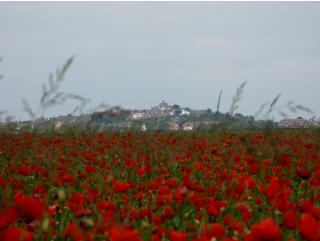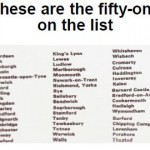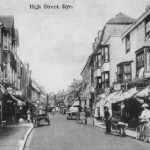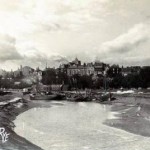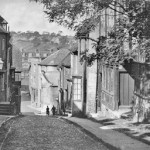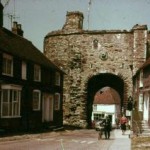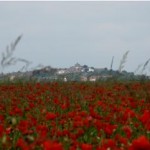This Article was Reprinted by kind permission of the Civic Trust and Architects Journal in the “Rye’s Own” July 1968 edition.
Rye on the Short List for Preservation CBA list of historic towns
In 1964 the Council for British Archaeology issued a memorandum drawing attention to the implications of the Buchanan report, Traffic in towns, for preserving ‘historic town plans’ and buildings. The memorandum also promised a list of towns in Britain, the historic quality of which particularly required careful treatment in planning or redevelopment proposals. This list of historic towns was subsequently published in July 1965. The council’s list contains 324 towns of which 51 were considered to be of special importance
The inclusion of any town in the list was regarded by the council as “an argument for preparing for it a comprehensive survey of the historic environment, illustrating it’s layout, Its historic buildings, it’s urban quality and any other special characteristics. This ‘heritage plan’ should, with the transportation plan’ suggested in the Buchanan report, form an obligatory part of the development plan process and should make specific provision for conservation of the features emphasised by the survey. The short-listed fifty-one towns were regarded as ‘so splendid and so precious that ultimate responsibility for them should be a national concern.
These are the fifty-one on the list.
Rye in the Top Five
Rye was judged to be in the TOP FIVE worthy of preservation, along with York, Canterbury, Cambridge and Edinburgh, and a special plan based on the Zermatt Scheme was prepared and put forward for the Ancient Town.
Rye, perhaps most beautiful of the Cinque Ports, rises compactly from the surrounding marshland within the line of its ancient wall. It is a town of fewer than 4,400 inhabitants, considerably swollen in summer by visitors. Zermatt, high in the Swiss Alps, is a holiday resort of 2800 permanent residents and 13000 visitors at the height of the season.
Zermatt relies completely upon battery electric transport for all deliveries. During 1968 to supply sixty shops, seventy-five hotels and restaurants, and 1200 flats and houses 5300 tons of consumable goods were delivered in Individual packs. Zermatt’s transport fleet is made up of eighteen 1 ton utility vehicles for passengers and goods, and twenty-two 3 ton to 4 ton goods vehicles. Could Rye do likewise and exclude conventional vehicles from the historic area within the wall? The plan shows a possible route arrangement for an electric vehicle system, with a suggested location for transport interchange.
New vehicles for towns
Reprinted by kind permission of The Civic Trust and Architects Journal in July 1968 Issue of “Rye’s Own”.
For too long we have accepted without question the need to adapt our towns to the present family of vehicles. The realisation that we can never satisfactorily alter the tight-knit historic centres of most of our existing towns to take these vehicles in growing numbers is, however, dawning slowly. The time is ripe for a determined effort to see whether (perhaps only experimentally at first) it is not possible to invent new types of vehicle, tailored to the narrow streets of our existing towns.
Such vehicles would need to be small, compact, manoeuvrable, of uniform size, and capable of even (rather than great) speeds. They should be quiet; easy to get into and out of quickly. A variety of services should be offered in fully public, semi-public and private-hire forms.
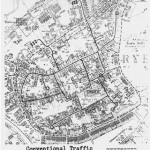
Fare structure should be simple. Some services might be municipally run and free. We must accept, in this mechanical age, the need to be vehicle-borne for the movement of both people and goods. The Ideal of the individual personal vehicle is a magnificent one and should be pursued to the maximum possible extent. But since we are gregarious, since we love to congregate in crowds and converge upon busy centres, then when we do so (whether for business or leisure) we shall have to learn to give up the undisputed right to go absolutely everywhere and anywhere in our own private vehicles.
The task industry, and of government, is to supply a viable and attractive means of transport in crowded places which offers an alternative to the unbridled use of individual vehicles. In the present state of play, no one is winning in the traffic-in-towns game. The motorist is frustrated and often angry at not being able to penetrate to his target. He is niggled and harried by overworked police and traffic wardens: lectured by an increasing array of signs and symbols. He is paying more and more in meter fees and garaging charges. More often than not, nowadays, he has to get out of his car well away from his actual destination. Even then he Is probably committing some parking offence.
Would not the motorist be better off If some areas were denied to him provided that in return he could enjoy a regular, uninterrupted, cheap form of public or semi-public transport and efficient car-hire services? The lot of the pedestrian in town centres, too, becomes daily more intolerable, more dangerous and more unpleasant: waiting, for longer periods, to dodge across the road; being assaulted by exhaust fumes: battered by an increasing volume of noise and subjected to increasing danger to life and limb. Nor can the bus companies do their job because everyone is getting in everyone’s way. The less regular buses are, the less useful they are. The downward spiral of public transport is a well known modern phenomenon.
More and more people generally are becoming involved in coping with the increasingly impossible task of controlling one of the greatest inventions of modern times – the privately owned, privately driven, massed produced vehicle. But while more and more people are thus involved, solutions are getting more and more remote. Efficiency is diminishing and the benefits which the private vehicle out to give are dwindling away-at any rate in towns. The appearance of our towns too is suffering, just as much as the nerves of its people. The proliferation of white lines, yellow lines, red lines, yellow boxes and white triangles painted on street surfaces is becoming more and more bewildering to motorist and walker. Traffic lights, directional signs and notices of increasing complexity and size are defacing beautiful buildings and dominating street scenes.
In addition it is rapidly becoming impossible to look at the town-scape because of the overwhelming mass of moving and parked vehicles. The idea put forward here is that there are certain parts of towns (notably the central core of towns and areas of great historic and architectural value and character) which should no longer be made available to conventional, privately owned vehicles-whether motor cars or commercial vehicles. Such areas throughout the country should be declared to be controlled vehicle zones, provided that, before they are so designated, adequate and attractive alternative arrangements have been made for moving people and goods in public, semi-public or private hire vehicles. Petrol & Diesel Vehicles
The range of petrol or diesel vehicles for popular mass use is limited. The types are: the all-purpose motor car (whether Mini or Rolls): the taxi; the bus; the coach; the van; the lorry; the motor cycle and the scooter. These eight types, whatever their size, are expected to go everywhere and do everything, without let or hindrance, in town and countryside, for business or pleasure. But none of them functions efficiently on the restricted roads in centres of cities, particularly of historic cities. Nor does it seem remotely possible that we shall be able to rebuild all our hundreds of centres to suit the demands of this limited range of present day vehicles. Even if It were possible, it would be highly undesirable in most cases, since the town centres would be so altered that their character would be totally destroyed. In some spheres vehicles have been specially designed to perform specific tasks and adapted to operate In certain physical surroundings. For instance, the army has developed specialised vehicles for different purposes: the tank and amphibian vehicle are good examples.
Milk companies use specially designed electric vehicles for their rounds-men. There are whole ranges of electric trucks in use at railway stations, in warehouses and in factories for moving, loading and stacking goods. We ought to develop a new series of vehicles to suit the conditions in restricted town centres. Vehicle manufacturers and designers are quite remote from those who design and plan towns, buildings and roads. Planners, architects, and civil engineers blindly accept the vehicles being currently produced and design their towns. buildings, bridges and roads to suit those vehicles’ requirements. There is a fatal lack of communication here – the more so because cars have a short life and buildings or towns have a long one. The difference is startling. Modern cars last about five years, whereas buildings last from 100 to 1000 years. Should the relative permanence of towns or buildings not take precedence over vehicle design?
The built environment and vehicle manufacture are not two subjects: they are one and indivisible. Electric battery-driven vehicles seem most promising for development in town centres. Quietness is one of their greatest attributes. They do not emit fumes. The electric motor needs little attention. Fuel costs are low. Vehicles have a long life (ten years may be taken as a minimum). Maintenance is minimal. Operation is simple. Excessive size and speed are not characteristic of these vehicles, but neither are these attributes required for town work. A steady speed of three or four times that of walking (nine to twelve miles an hour) is all that is needed. Such a service as this, operated by a fleet of purpose-built vehicles of uniform size, would go a long way towards eliminating accidents and making towns more peaceful and pleasant places to live in.
The basic list of vehicles to be evolved specifically for town-centre work, would include single decker and mini-buses, designed to accommodate seated or standing passengers for short ‘hop-on, hop-off’ journeys. Short trains of platform trucks for passengers, towed by a powered tug, could be evolved. They would trundle at frequent intervals around central areas with set stopping places. Such vehicles are already to be found at airports and in large factories. With the elimination of private motor cars and commercial vehicles, they could operate in our streets with regularity, efficiency and frequency. With further experiment and the application of technical inventiveness they could be made to run as un-manned vehicles over defined routes, controlled from a central master-computer-as is now being done with phased traffic lights.
In addition there would be taxis for two or more people. More versatile, more individual and therefore more expensive, these would be either conventional or coin operated and self-driven. The third type of machine would be the tiny-scale pedestrian aids, such as dodgem cars, scooters and ‘supermarket’ trolleys. To achieve this controlled vehicle zone, a way round it would have to be made for through traffic. Interchange points would also have to be provided between one form of transport and another.
Cars would have to be left at car-parks on the periphery. Use of the area by vans and lorries would have to be cut to a minimum. Goods depots should therefore be established on the periphery of the traffic-controlled zone. Shopkeepers would be allocated space in these warehouses to which their goods would be delivered in bulk. Merchandise would be fetched to the retail counter by an electric vehicle delivery service, in the form of small trucks or hand-carts. The type of vehicle needed is already in commercial production. These vehicles could be owned and operated municipally or privately. Delivery of bulky or perishable goods direct to shops would still be needed in certain cases, but these would be permitted only at off-peak times.
There is already a substantial range of electric vehicles for public utility services, ambulances, refuse collection and even fire engines. There would remain some special problems such as entry for vehicles in connection with building works and so on, for which exemptions from control would have to be allowed by regulations. Thus a new form of movement would be created in vehicles tailored to specific needs and built to suit the circumstances of existing towns. We are on the verge of a breakthrough in the development of battery driven vehicles.
The range in use, even in commercial activities is impressive. Intensive research is going on to overcome the power-weight duration-charge disadvantages of present electric batteries. It seems likely that success will be achieved soon. The lightweight fuel cell that can be ‘fed’ with fuel as easily as the petrol engine is bound to come sooner or later. Many other types of fixed equipment can aid the movement of people in thickly populated areas. They include moving pavements, and miniature monorails.
The whole idea would be to approach the design problem of central areas in the way that international fairs are planned. These have to cater for thousands and tens of thousands of people daily. Wembley 1921, Lausanne 1965 and now the Montreal 1967 Expo are all fruitful examples of novel ideas in mass transport movement. What we need is a new approach -the kind of revolutionary look that Henry Ford had when he inadvertently ushered in mass-production and the mystique of the individual vehicle.
We ought to concentrate our vision upon experiments designed to provide acceptable prototypes whereby static town structure and moving equipment fit one to another, rather than destroy one another. Four places are suggested which might be studied in greater depth for such experiments. They are Rye, Canterbury, Cambridge and York. The structure of roads they possess at their centres is favourable to the kind of suggestion made here. They are all historic towns.
Above all it is important to remember that travel can be fun. Sharing journeys with other people is often as exhilarating as driving oneself. On holiday ‘going for rides is one of the great pleasures. Boat trips round the harbour; miniature railways along the seafront or up the mountain; Dodgems, scenic railways, roundabouts at the fair: all these are ‘perilous’ journeys we take for enjoyment with other people. Given a good service by novel purpose-built vehicles in the restricted areas of historic town centres, people would soon accept the need to get out of their car and ride with others. And the towns would again be worth walking and riding in.
Rye’s Own July 1968
Reprinted “Rye’s Own” November 2015
All articles, photographs, films and drawings on this web site are World Copyright Protected. No reproduction for publication without prior arrangement. (Hard Copy Back Numbers {November 2015} Still Available) © World Copyright 2016 Cinque Ports Magazines Rye Ltd., Guinea Hall Lodge Sellindge TN25 6EG
